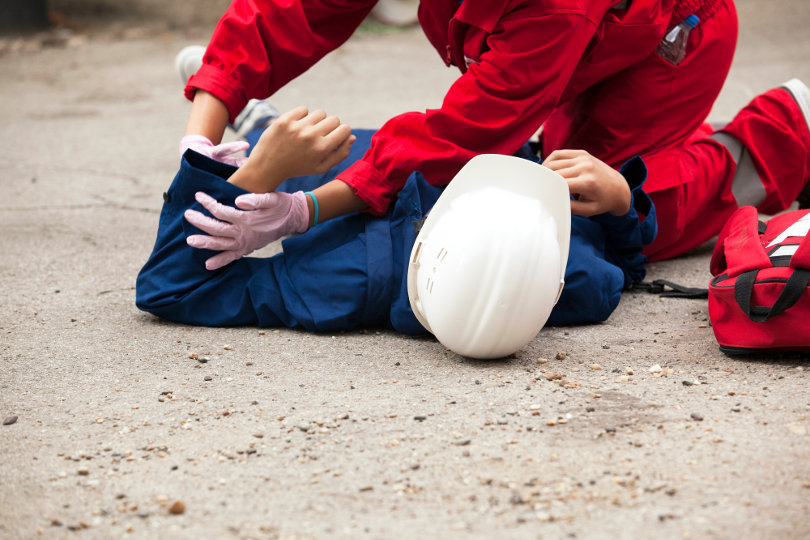Identifying risks, creating strict safety rules and procedures, and mandating the use of protective equipment can all help to keep your construction employees safe. But even in these relatively safe conditions, it’s possible that a worker could suffer an injury.
What do you do in this scenario? What are the best ways to handle a job-site injury?
![]()
Remain Calm
Clear and thorough communication is one of the most important principles to follow in post-injury reporting. It’s also important to act responsibly and decisively, so you can give the injured party the medical attention they need and secure the area.
You won’t be able to do any of this if you’re panicking about the situation. That’s why your highest and first priority should be remaining calm. In the aftermath of an injury, take a few deep breaths, focus on your main objectives, and try to keep the people around you similarly calm.
Prioritize Immediate Safety
Next, you need to prioritize the immediate safety of the injured person and the people around them. Your goal is to prevent further job-site injuries.
- Get the injured person to safety. If you can move the injured party safely, get them to a safe area. Make sure they’re not in a position to be injured further and that they’re as comfortable as possible for the current moment.
- Eliminate the risk of further injuries. Your next job is to eliminate the risk of further injuries, especially if this injury was the result of circumstances that continue to be threatening, such as a piece of equipment that is malfunctioning. Get other people in the area to safety, shut down equipment as necessary, and use emergency signage to communicate to others about potential risks.
- Secure emergency medical assistance. While you’re securing the area, have someone else secure medical assistance if necessary. Depending on the severity of the injury, that could mean driving the injured person to the hospital, calling an ambulance, or even providing emergency assistance on site.
Gather Information and Investigate
Once you’ve secured emergency medical assistance, you can begin gathering information and investigating the incident.
Take photos and videos of the injured party, if possible, as well as photos and videos of the environment where the incident took place. Take recordings of witness statements from anyone who saw the incident, and do your best to piece together a sequence of events. Try to be as detailed and thorough as possible in your initial reporting.
Provide Directions and Guidance to the Injured Parties
It’s a good idea to provide some guidance and direction to the person who was injured, or someone who can relay the information directly to them. For example, if you have a workers’ compensation insurance policy in place, explain to them how they can take advantage of it. Help them figure out the best way to take leave from work, whether that’s tapping into FMLA leave or taking traditional PTO.
File a Formal Report
Once you have all the details, you’ll be ready to file a formal report about the incident. Make sure you describe the incident in the fullest detail you can, noting what happened, where it happened, when it happened, who is involved, and perhaps most importantly, why this incident happened.
Identify the root causes, any safety lapses that could have led to this, and specific changes you can make in the future to prevent this from happening again.

Notify OSHA
In some cases, you may need to inform OSHA about the incident promptly. If there has been a fatality, OSHA must be notified within 8 hours; in-patient hospitalizations, amputations, and loss of eye incidents must be reported within 24 hours.
If you fail to report a significant injury or fatality when you’re required to do so, your organization may face steep fines or other legal consequences.
Reflect and Improve
Finally, take the time to reflect and improve your job-site. Whenever an injury occurs, there’s something you can learn and something you can change moving forward. It’s especially important to identify and remove hazards, including hazards that contributed to the recent injury.
- Communicate about the accident. Communicate with your entire crew about the accident. Make sure that everyone understands exactly what happened and how it happened, as well as how they can prevent an accident like this in the future. Someone injured is a grim reminder that everyone on the job-site is vulnerable to injury.
- Change policies (if necessary). If this injury was a result of failed policies or unidentified safety hazards, consider instituting new policies or changing your existing ones. For example, you may mandate a new piece of PPE to be worn in a certain area.
- Provide training and education. This is an excellent opportunity to provide more training and education to your job-site employees. What steps can they take to make the workplace environment safer for themselves and everyone around them?
- Consider adjustments to your response plan. This is also a chance for you to review your response plan and see if it needs to be adjusted. When the person was injured, were they able to get help right away? Were you able to do a thorough investigation and uncover the root causes of the accident? If not, consider adjusting your approach to injury response.
Nobody likes to see a job-site injury, especially if you’re the one responsible for maintaining job-site safety. But if you have a proper response plan in place, and you can remain calm while communicating clearly throughout the process, you’ll be in a much better position to recover from the injury quickly and fully.






